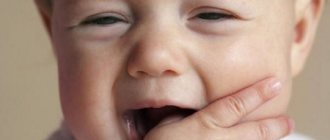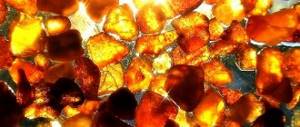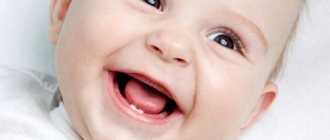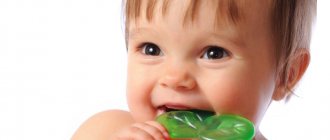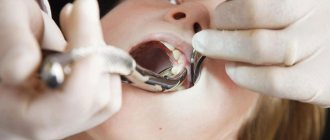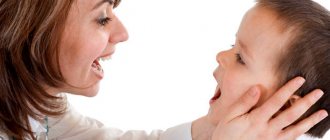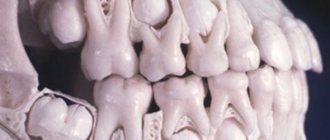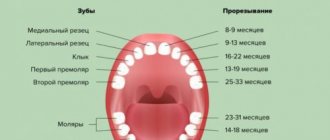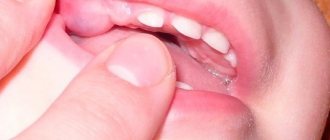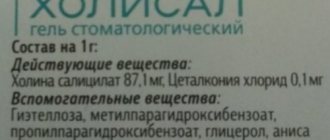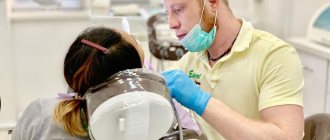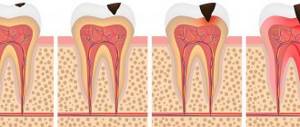Drooling is common in young children, especially during teething. It is usually not a cause for concern. However, excessive drooling can sometimes irritate your baby's skin and cause a rash around the mouth. This rash is not contagious and is not associated with any underlying medical conditions. However, teething can indirectly lead to red, itchy patches on the skin that are painful and cause discomfort to the baby. They can be wet or dry.
Drooling is natural and can be a side effect of teething. In addition, drooling in infants can cause:
- limited swallowing ability;
- missing front teeth;
- habit of keeping your mouth open.
Or maybe this rash is not on the teeth?
The rash can be caused by a variety of viruses and is usually associated with fever.
According to the American Academy of Pediatrics, teething may be accompanied by a slight increase in body temperature (below 38C), but this is not considered fever, which is characteristic of viruses.
Red, puffy patches may also be eczema, known as atopic dermatitis. True, most often, unlike a rash on the teeth, eczema appears on the folds (behind the knees and ears, in the inner bends of the elbows and on the hands).
What phenomena often accompany teething?
During teething, the baby experiences some discomfort. A baby tooth passes through the mucous membrane of the gum, injuring it. This natural process, established by nature, is painful for the child. The gums swell and become sensitive. Due to constant aching pain, the baby cannot sleep or eat normally. Due to severe stress, the immune defense is weakened, which affects the child’s health.
A teething rash is a fairly common sign that signals that the first tooth will soon appear in your baby's mouth. In some children, teething occurs without any consequences, while others become extremely irritable and capricious. If your restless behavior is accompanied by a body rash and fever, this is likely a reaction to pain and stress.
How can you prevent tooth rashes from appearing?
Here are some tips to help avoid dental rashes:
- Wipe drool gently and frequently with a soft cloth to remove the irritant.
- Stock up on soft bibs that will stop drooling.
- Change clothes wet from drool to dry ones.
- Use petroleum jelly or a healing baby ointment containing petroleum jelly (for example, Aquaphor), which will create a barrier to protect the skin from drooling.
Dr. Jones assures that getting a small amount of ointment on a child's lips is harmless.
You can also use lanolin ointment.
Experts' opinion
ASEPTA toothpastes are clinically proven effective. The results of studies of toothpastes, napkins, rinses, balms and other ASEPTA products are regularly published on our website. The effect of the products produced is tested in our own laboratory at the VERTEX research center. All products have certificates of conformity.
- Why does your jaw hurt when chewing and when does it become dangerous?
Sources:
- Study of the clinical effectiveness of the use of therapeutic and prophylactic agents of the ASEPTA series in the treatment of inflammatory periodontal diseases in children and adolescents (I.V. Klimova) Irina Vladimirovna Klimova, Candidate of Medical Sciences, Associate Professor of the Department of Pediatric Dentistry, Novosibirsk State Medical University. Department of Pediatric Dentistry, Novosibirsk State Medical University.
- The use of drugs from the Asepta line in the complex treatment of inflammatory periodontal diseases (N.V. Berezina E.N. Silantyeva S.M. Krivonos, Kazan State Medical Academy. Kazan.) N.V. BEREZINA, E.N. SILANTIEVA, S.M. KRIVONOS Kazan State Medical Academy
- Clinical experience in using the Asepta series of products Fuchs Elena Ivanovna Assistant of the Department of Therapeutic and Pediatric Dentistry State Budgetary Educational Institution of Higher Professional Education Ryazan State Medical University named after Academician I.P. Pavlova of the Ministry of Health and Social Development of the Russian Federation (GBOU VPO RyazSMU Ministry of Health and Social Development of Russia)
How to get rid of a rash if it has already appeared?
If your baby develops a small rash, you should follow the same rules as for prevention, namely, carefully wipe off drool, change wet shirts and bibs, use barrier ointment, and make sure the baby’s skin is clean and dry.
"You should also limit the use of other potential skin irritants, such as lotions with fragrances and dyes," Dr. Jones advises.
Wash your baby's skin with warm water several times a day. After washing, pat it dry.
Try to limit your pacifier use if possible, as drool can accumulate between the pacifier and your skin.
If your teeth rash causes your skin to crack or bleed, you should see a doctor. Most likely, he will recommend using hydrocortisone cream.
On the Vikids platform you can:
What kind of rash occurs and why does it occur?
A rash on a child’s body can appear for many reasons, not just when teething; it may also be that the parents simply gave the baby new complementary foods or he became infected with something. You need to make sure that the child is completely healthy and there are no allergenic substances around him, for example, low-quality household chemicals or food. Any of these factors can cause a child to develop a rash on any part of the body. It may appear as redness, be hard or flaky to the touch, itch or sting when touched, and may appear as clusters of pimples or blisters. In any of these cases, the first step is to visit a pediatrician.
If the rash is still not associated with any factors other than teething, you must first determine the location of its main location before moving on to treatment.
Where does the teething rash appear and can it spread beyond the baby's face?
As a rule, such a rash, which can be attributed to teething, begins in the area of the child’s head (face) and neck and looks like in the photo. It spreads in stages, from the place of first localization to more distant places on the body. The next stage is usually the arms, and then the rest of the body and legs. The rash itself feels like a very dry area, sometimes flaking, with increased skin temperature at the site of the rash. In any case, no matter what the rash looks like, it should always be under the careful supervision of parents.
If you notice a rash on your child’s face and are sure that he is absolutely not sick with anything, you should visit a doctor and consult with him what needs to be changed in the child’s routine so that the rash disappears.
Consumer Reviews
smagina162014 (irecommend.ru)
“When my son turned 4 years old, we were faced with the question of what toothpaste to buy now, because our age was no longer suitable for children. I asked some moms I knew, surfed the Internet and decided to try Asepta Kids for 4 to 8 year olds. I was attracted by the fact that the composition does not contain fluoride, parabens, sodium lauryl sulfate or antiseptics. Plus, the paste has a pleasant gel consistency that does not damage the child’s delicate tooth enamel. I've been brushing my teeth with this toothpaste for a month now. Sanya really likes the taste of tutti-frutti pasta. “And I noticed that the condition of my gums and teeth has noticeably improved.”
Polya Zvronova (irecommend.ru)
“My one-year-old is trying to brush his teeth by himself. To do this, I buy Asepta Baby paste, because at first the baby can’t get used to not swallowing the paste, every now and then he swallows a little. In this regard, Asepta is captivating because it is safe, there are no questionable components in its composition. In addition, Asept does not contain fluoride, so you can buy it without consulting a doctor, the dentist told me about this - so to speak, he took the bread from his colleagues)
The dentist also says that Asepta baby allows you to take care of your teeth and gums, and is ideal for children’s baby teeth. Removes plaque from my son’s teeth, they are snow-white. The consistency of the paste is transparent - gel-like, and very gently cleanses the mouth.
And, of course, one cannot ignore such an important point for little ones as taste. The pasta is delicious (I tried it))), tastes like tutti-frutti chewing gum. If your kids are capricious and don’t have the desire to brush their teeth, try giving this toothpaste, brushing without hysterics is possible with it.”
Source
How to help your child when he is teething
Infants are very sensitive to the behavior of their parents, so it is important to remain calm and pay as much attention to the baby as possible: carry them in your arms, distract them with toys, avoid quarrels. Breastfed babies will more often ask for the breast as it calms them down, it is important not to deny him this. During the growth of the baby's teeth, it is recommended to give teethers, which are made of safe materials and can alleviate his condition. Or it can be any toy that does not have small parts that can be chewed off.
You can also help your child with the following medications:
- Dantinorm baby
is a homeopathic remedy in the form of a solution that has a calming effect and relieves discomfort. - Dentokid
is a homeopathic remedy that relieves all unpleasant symptoms, including eating disorders, runny nose and fever. - Kamistad Baby Gel
– has an anti-inflammatory, regenerating and antiseptic effect thanks to lidocaine and chamomile, recommended for children over three months old. - Cholisal gel
– has an analgesic, anti-inflammatory and antimicrobial effect; it must be used with caution, as an allergic reaction is possible.
During the period when a child’s teeth are growing, it is difficult for both the baby and his parents. Children's crying and restless behavior accompanies this inevitable process. You just need to go through this period, supporting the child as much as possible and perceiving this as another stage of growing up.
Source
Treatment of atopic dermatitis in children
In this article, we will pay great attention to the treatment of this disease, and will also talk about the main features of the use of medications in children with atopic dermatitis.
The basis of treatment is external therapy using various medications. The goal of external (local) therapy is the complete elimination of inflammatory changes, itching, as well as restoration of the water-lipid layer of the skin. Local glucocorticosteroids (hormones), calcineurin inhibitors, and emollients are used as such agents. We will pay special attention to emollients. Emollients are medicinal cosmetics that care for the skin and prevent dry skin. In some cases, systemic therapy is also prescribed. Systemic therapy refers to the use of drugs that are administered orally. Antihistamines are most often used as systemic therapy.
Below we consider the most common drugs for the treatment of blood pressure in children.
The goal of local therapy for atopic dermatitis is the complete elimination of inflammatory changes and itching.
Hormones
Local glucocorticosteroids (MGS) are used as hormones. They are the most powerful drugs at the onset of the disease, which allows the symptoms of this disease to be eliminated in the shortest possible time. The duration of use of these drugs should not exceed two weeks. If possible, use of MGCs should be short.
What parents should remember when using these products:
- It is not recommended to mix MHA with other agents.
- When the symptoms of the disease decrease, it is necessary to reduce the amount and frequency of MHA use.
- In the event of a bacterial or fungal infection, it is necessary to use a combination of MHA with antibacterial and antifungal drugs.
- Do not apply these medications under closed dressings.
- With long-term use, complications may develop. Such complications include: stretch marks, telangiectasia, skin atrophy. Striae are white to pink stripes on the skin. Telangiectasia is popularly called “spider veins”. This complication is a vascular formation with dilated vessels. Atrophy is characterized by a skin defect with a change in its volume and elastic properties.
Local hormones exist in different classes, depending on the strength of their action. The most common MGCs are: celestoderm, elokom, lokoid, dermovate, cutivate.
Calcineurin inhibitors (CI)
A special feature of these drugs is the absence of complications inherent to hormones. They can be used together with hormones. After eliminating symptoms, MGC can be replaced with IR, which will avoid the development of complications. The two most common medications in this group are pimecrolimus and tacrolimus. Pimecrolimus is used for mild cases, while tacrolimus is used for severe cases.
Remedies for atopic dermatitis
Atopic dermatitis (AD) in children is one of the most common diseases of young children. This disease is an allergic inflammation of the skin, which is characterized by itching, as well as frequent relapses and age-related characteristics of the skin rash. As a rule, dermatitis appears at an early age; if left untreated, it continues to progress into older age, which significantly worsens the quality of life of patients and their families.
For the development of this pathology, a hereditary predisposition to the development of allergies is of great importance. Therefore, this disease is often combined with other forms of allergies, for example, bronchial asthma, allergic conjunctivitis and rhinitis, food allergies. There is such a thing as “atopic march” . Atopic march is a natural development of allergic diseases. As a rule, it all starts with a food allergy, which often gives impetus to the development of atopic dermatitis. In the absence of adequate treatment, the march progresses. Over time, the child develops allergic rhinitis. Over time, a more dangerous, in some cases, life-threatening condition arises - bronchial asthma.
Symptoms
Depending on the different stages and stages of teething, the rashes can be localized on different parts of the body. As a rule, irritation is localized in the area of the neck folds . It is also possible for the rash to spread to the upper and lower extremities, abdomen and back.
The nature of the rash may be:
- Dry.
- Rough.
- Accompanied by severe itching.
Rash on the torso
The causes of rashes on the body, with slight roughness, can be reactions to stress, since in the process of teething, the nervous system is heavily overloaded, and the psycho-emotional state of the baby is not stable.
One of the most serious causes of teething allergies is an acute lack of calcium. Since at the time of the teething process, there is a need to increase the concentration of this component in the body. Don't ignore rashes on your baby's skin!
Prevalence of atopic dermatitis in children
It is safe to say that this disease can occur in any country, in both males and females. Dermatitis occurs in different age categories. The prevalence of AD is higher in residents of economically developed countries, which may be due to the urban lifestyle of this population. According to the protocol for the treatment of blood pressure in children, the prevalence of this pathology in the Russian Federation ranges from 6 to 15% according to ISSAC. ISAAC is a standardized epidemiological study - the International Study of Asthma and Allergy in Childhood. Repeated studies within the framework of this program show a significant increase in the prevalence of AD in children of the Russian Federation.
Research shows a significant increase in the prevalence of atopic dermatitis in children in the Russian Federation.
Also, the expert committee on asthma and allergy of the WHO European Bureau developed and approved another program - GA2LEN. GA2LEN (Global Allergy and Asthma European Network) studied the incidence of allergic pathology among adolescents aged 15 to 18 years. According to the study, the presence of symptoms of AD occurred in 33% of adolescents, the prevalence of AD according to questionnaires was 10%, and a confirmed diagnosis was found in 7% of adolescents. Girls have 1.5 times more than boys.
